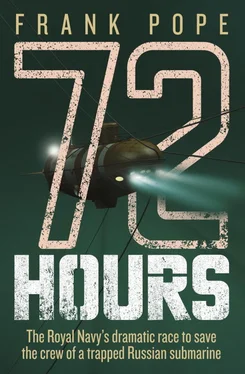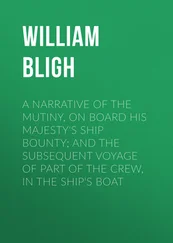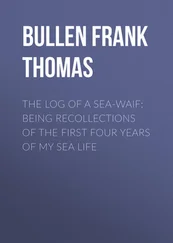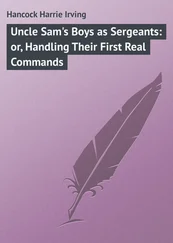But there was a critical problem. Neither had been out at sea when the alert came out, and Japan was a full three-and-a-half days’ sailing from the incident site. No one believed the crew of AS-28 would survive that long.
Friday, 5 August
SS + 28 h 30 mins
09.00 UK – 12.00 Moscow – 21.00 Kamchatka
Cowes, Isle of Wight
While Riches was working the phones, Roger Chapman was coiling the mooring rope of his cherished ten-metre, gaff-rigged sailing boat, squinting across the water into the morning sun to see how the previous race in the regatta was faring. It was Cowes Week, the highlight of his sailing year. He was in heaven; as yet he had no idea that his weekend was going to be turned upside down, and that the whole of his professional life was about to be put to the test.
It was Chapman’s love of sailing that had made him keep his base in the Lake District when most of the offshore opportunities had moved to Aberdeen as part of the Great North Sea Oil Rush. He hadn’t fancied swapping the beautiful lakes for the dour grey of Scotland’s east coast, no matter how glittering the pay packets. There was more to life than that, so his company, Rumic, had remained based in the Lake District.
Chapman had always done things for the passion of doing them, not simply for the money. He’d joined the Navy because of his feeling for the sea, and submarines had felt a natural choice. As a Lieutenant, he’d worked all the way up to the position of Navigator of HMS Swiftsure before they’d discovered a flaw with his eyesight and told him that he wouldn’t be allowed to drive the new nuclear boats. They offered him freedom or an office, and he’d decided on freedom. As he saw it, there was no point in staying in the Navy if he didn’t get to be out at sea.
Luckily, in 1971, submersibles were the hot new thing in the offshore oil and underwater-cable-laying industries, and Barrow-in-Furness was the centre of the world for subsea vehicles. On leaving HMS Swiftsure, all he had to do was walk over the jetty to the offices of Vickers Oceanics, an offshoot of the company that had built Swiftsure , and straight into a job. It had recently started operating submersibles commercially and was looking for pilots.
Two years later, in August 1973, Chapman was in the North Atlantic on a cable-laying job when the accident happened. He and his co-pilot, Roger Malinson, had just surfaced in their Vickers Oceanics Pisces III after a long survey dive. The sea was rough, but the North Atlantic was rarely calm and they were used to operating in bad conditions. A swimmer was in the water attaching the lifting hook, and both men were looking forward to a cup of tea and a bacon roll back on board the mothership. But, as they were being reeled in towards the vessel, Chapman and Malinson were suddenly flung across the tiny confines of the submersible’s interior. Although they did not yet know it, the cable that had been towing them back to the mothership had somehow wrapped around a hexagonal nut and loosened it, causing a hatch to pop open and the aft buoyancy tank to flood with water and pitch the submersible backwards. The stern was sinking rapidly.
Confused and disoriented, it took them a couple of seconds to realise that their worst fears were coming true. Outside the porthole, the shallow, sunlit scene was rapidly darkening. The submersible was plummeting back down to the bottom: 480 metres down, they finally crashed stern-first into the seabed.
The two men lay in their upturned steel coffin, trying to conserve their air and endure the cold while sister submersibles owned by the company were scrambled from hundreds of miles away to search for them. Pisces III was designed to support them for two days, but the craft had landed in a dip in the seabed and was hidden from the probing sonars of the searching submersibles, and it was 76 hours before the Pisces II submersible finally found them and managed to attach the line that would bring them to the surface. It was the deepest rescue anybody had yet pulled off, and it inspired in Chapman a lifelong interest in saving those trapped beneath the sea.
A decade later, Chapman’s company designed and began operating the UK’s Submarine Rescue Service, centred around the LR5 submersible. The company had been running the 365-day-a-year contract – worth between £2m and £3m a year – for 18 years now, but the closest they’d got to seeing action was during the Kursk. Yet none of their equipment had even got wet, and now the chance for his team to prove themselves was fading.
Rumic’s contract with the Royal Navy was about to come to an end. The UK had signed up for a new rescue system that would be shared with other NATO countries. The idea had been kicking around as long ago as 1990: with submarine accidents a rarity, why not pool the resources of submariner nations into a single rescue system? The concept of the NATO Submarine Rescue System was born, but it soon became apparent that not all nations were equally enthusiastic. France, Italy, Norway, Turkey, the UK and the US were all interested at one stage or another, but when it came time to sign up in 2003, only France, Norway and the UK remained in the group. It was enough, however, and plans began to be drawn up.
Chapman had fought hard to win the contract. On its own, Rumic didn’t stand a chance of being thought capable of building and operating the £47m project, so he’d allied his company with shipping giant James Fisher Ltd in order to make it appear big enough to compete. It hadn’t worked. In May 2004 Rolls-Royce was awarded the contract, beating subsea engineering firms Slingsby and Global Marine. In under two years’ time, in March 2007, the UK’s Submarine Rescue Service would cease to exist, and there seemed a good chance it would never have been used other than in exercises. Much as he loved spending time on his sailboat, he would much rather retire having shown the world what they were capable of.
That morning Chapman’s thoughts were on the surface of the sea, not its depths. When his phone went and the rescue team manager Sam Sampson told him what was happening on the other side of the planet, his mind snapped back underwater.
Rumic’s contract with the Royal Navy stated that rescue teams had to accomplish the first rescue intervention within 72 hours of the call, wherever in the world the accident had happened. As the chairman of Vickers Oceanics had said during Chapman’s accident, ‘The history of submarine accidents is the running out of time.’
Chapman left his boat with his crew and began making his way north. The clock was already ticking.
Friday, 5 August
SS + 29 h
09.30 UK – 12.30 Moscow – 21.30 Kamchatka
AS-28 , 210 metres beneath Berezovya Bay
Through the persistent, bone-aching cold the crew of AS-28 were now beginning to feel the effects of the foul air, their heads throbbing from the combination of oxygen deprivation and carbon dioxide build-up. Captain Lepetyukha was holding out as long as possible before opening each new V-64 cartridge, all too aware of the limits of his supply.
The canisters – each the size of a five-litre tin of paint – contained soda lime to absorb carbon dioxide and potassium superoxide to generate oxygen. Once opened, they were usually placed in a metal unit on the wall that contained a fan to circulate the air. But they couldn’t risk using up power to run the fan, so the V-64 canister currently open was perched precariously above the main motor. To try and coax more life-giving gas from the canisters, Bolonin had suggested that the crew sprinkle a little of their precious water on to the chemicals. He knew from experience that the water would begin a chemical reaction that could coax an extra hour or two from each can.
Читать дальше












